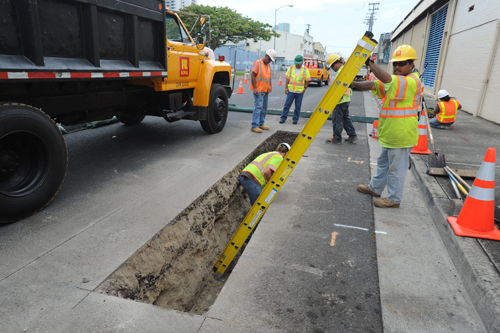Judge deals rail setback but dismisses bulk of plaintiffs’ claims

2012 MAY 31 CTY Shoot archeological survey being done for the rail project. AIS trench work Tuesday in Kaka`ako on Pohukaina Street between Keawe and Cooke Street next to Mother Waldron Park. SA photo by Craig T. Kojima
A federal judge has dealt another legal setback to the $5.26 billion Honolulu rail project.
Federal Judge A. Wallace Tashima ruled today the city "failed to complete reasonable efforts to identify" traditional cultural properties along the 20-mile proposed rail line, and ordered the city to identify those properties.
"Before continuing with the project in any way that may use unidentified (traditional cultural properties) defendants must complete their identification of above-ground TCPs within the corridor," the ruling says.
The city also didn’t adequately consider building a Beretania Street tunnel as part of an alternative to a rail line and didn’t properly evaluate whether the rail project would constructively use a Mother Waldron Park in Kakaako, the judge ruled.
Tashima also ruled the Federal Transit Administration must supplement the record of decision for the rail line before work can resume.
The judge didn’t find problems with how the city has handled burial sites along the route. He also didn’t order the project to stop, though he said it may be appropriate to issue an injunction in the case.
Don't miss out on what's happening!
Stay in touch with breaking news, as it happens, conveniently in your email inbox. It's FREE!
He scheduled a Dec. 12 hearing to hear arguments on issuing a permanent injunction in the project. The lawsuit was filed by a group of rail opponents, including former Gov. Ben Cayetano, who is running for mayor against rail supporter Kirk Caldwell.
City and the Honolulu Authority for Rapid Transportation officials noted that the judge dismissed most of the claims of the plaintiffs.
"We are confident that a reasonable remedy can address the remaining issues in a timely manner." Mayor Peter Carlisle said in a news release. "Today’s ruling will require further analysis, but the bottom line is that the project can and should continue moving forward."
Daniel Grabauskas, executive director of HART, said the rail project "remains on course."
He said Tashima ruled in the city’s favor on 20 of the 23 claims made by rail opponents, and "flatly rejected the vast majority of the plaintiff’s claims."
"On all the major issues, we have successfully shown that the project properly conducted the required analyses and environmental studies," Grabauskas said in a written statement. "The ruling underscores the fact that the majority of alternatives were given proper consideration, including BRT, at-grade light rail and managed lanes. We will be carefully examining the ruling to determine what further course of action is needed."
All construction on the rail line was halted in August after the Hawaii Supreme Court ruled the city was required to complete an archeological survey of the entire 20-mile rail line before construction could begin. The city had been conducting the survey in sections, and still has not completed that work.
The city estimates the Supreme Court ruling will cause $64 million to $95 million in delay costs.
Michael Green, an attorney for the plaintiffs, said the ruling was “a major victory.”
“They’re going to go back to the drawing board, and that drawing board is going to cost millions and millions of dollars,” Green said. He said it was “unfair to the people” for the project’s supporters to deny this.
———
The Associated Press contributed to this report.



